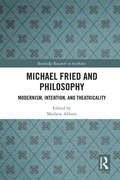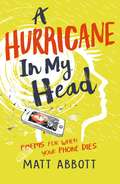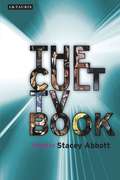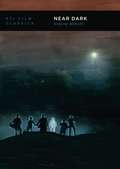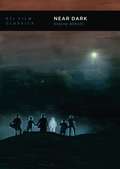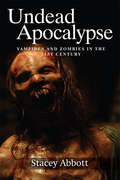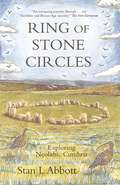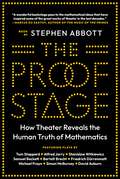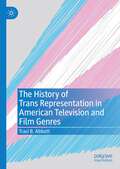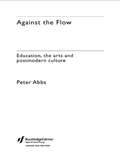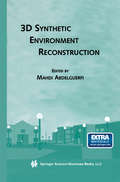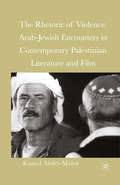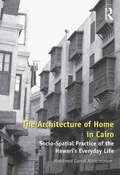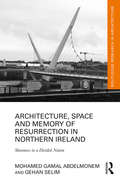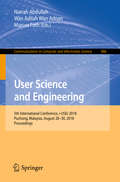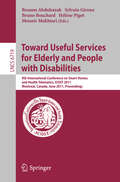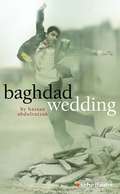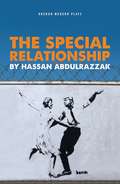- Table View
- List View
Michael Fried and Philosophy: Modernism, Intention, and Theatricality (Routledge Research in Aesthetics)
by Mathew AbbottThis volume brings philosophers, art historians, intellectual historians, and literary scholars together to argue for the philosophical significance of Michael Fried’s art history and criticism. It demonstrates that Fried’s work on modernism, artistic intention, the ontology of art, theatricality, and anti-theatricality can throw new light on problems in and beyond philosophical aesthetics. Featuring an essay by Fried and articles from world-leading scholars, this collection engages with philosophical themes from Fried’s texts, and clarifies the relevance to his work of philosophers such as Ludwig Wittgenstein, Stanley Cavell, Morris Weitz, Elizabeth Anscombe, Arthur Danto, George Dickie, Immanuel Kant, Friedrich Schiller, G. W. F. Hegel, Arthur Schopenhauer, Friedrich Nietzsche, Denis Diderot, Maurice Merleau-Ponty, Roland Barthes, Jacques Rancière, and Søren Kierkegaard. As it makes a case for the importance of Fried for philosophy, this volume contributes to current debates in analytic and continental aesthetics, philosophy of action, philosophy of history, political philosophy, modernism studies, literary studies, and art theory.
Michael Fried and Philosophy: Modernism, Intention, and Theatricality (Routledge Research in Aesthetics)
by Mathew AbbottThis volume brings philosophers, art historians, intellectual historians, and literary scholars together to argue for the philosophical significance of Michael Fried’s art history and criticism. It demonstrates that Fried’s work on modernism, artistic intention, the ontology of art, theatricality, and anti-theatricality can throw new light on problems in and beyond philosophical aesthetics. Featuring an essay by Fried and articles from world-leading scholars, this collection engages with philosophical themes from Fried’s texts, and clarifies the relevance to his work of philosophers such as Ludwig Wittgenstein, Stanley Cavell, Morris Weitz, Elizabeth Anscombe, Arthur Danto, George Dickie, Immanuel Kant, Friedrich Schiller, G. W. F. Hegel, Arthur Schopenhauer, Friedrich Nietzsche, Denis Diderot, Maurice Merleau-Ponty, Roland Barthes, Jacques Rancière, and Søren Kierkegaard. As it makes a case for the importance of Fried for philosophy, this volume contributes to current debates in analytic and continental aesthetics, philosophy of action, philosophy of history, political philosophy, modernism studies, literary studies, and art theory.
A Hurricane in my Head
by Matt AbbottWith surprising honesty and words that resonate long after reading, A Hurricane in My Head tackles the themes of friendship, bullying, technology and the life of a modern teenager. These poems say the things we can't always put into words; they may make you laugh, they may make you cry, but they will most definitely make you reminisce, escape, discover...This is a truly stunning collection from Matt Abbott, nationally acclaimed writer and performer, with poems that will make you want to become a poet and put your own words to paper – much to the perplexity of any careers advisor!
A Hurricane in my Head
by Matt AbbottWith surprising honesty and words that resonate long after reading, A Hurricane in My Head tackles the themes of friendship, bullying, technology and the life of a modern teenager. These poems say the things we can't always put into words; they may make you laugh, they may make you cry, but they will most definitely make you reminisce, escape, discover...This is a truly stunning collection from Matt Abbott, nationally acclaimed writer and performer, with poems that will make you want to become a poet and put your own words to paper – much to the perplexity of any careers advisor!
The Cult TV Book: From Star Trek To Dexter, New Approaches To Tv Outside The Box (Investigating Cult TV)
by Stacey AbbottCult TV is a very exciting area of contemporary television. The Cult TV Book is the companion reference to this TV phenomenon, whose shows push theboundaries and offer biting commentaries on society today.Cult TV is also changing. Where being cult used to mean being marginal with a small, loyal fan base, cult TV is now key to the television industry, fandom is global and online, cult status for a show is fostered by the networks, and cult series are noted for their spectacular special effects and sumptuous visual style.So, what is cult TV today? Leading scholars, writers and journalists redefine our understanding of cult TV, with new approaches to and case studies on: Cult TV aesthetics, History of cult TV, Cult TV & new media, The 'sub-cultural celebrity', Jane Espenson on how to write cult TV, Cult TV & the broadcast industry, Music, Innovation, Cult channels, Children's cult TV, Sex, Gender, Race, Cult audiences, Transgressive TV, Cult of cult TV, Nancy Holder on writing tie-ins, TV & Film Guide, Fan fiction, Battlestar Galactica, Buffy the Vampire Slayer, Doctor Who, The Avengers, The Prisoner, Quatermass, The Sopranos, Masters of Horror, The Twilight Zone, Twin Peaks, Grey's Anatomy, Bagpuss, South Park, The X Files, Da Ali G Show, Trailer Park Boys and Angel.Contributors: Stacey Abbott, Sergio Angelini, Jes Battis, Stan Beeler, Miles Booy, Simon Brown, Bronwen Calvert, Jane Espenson, Dick Fiddy, Lincoln Geraghty, Janet K. Halfyard, Matt Hills, Nancy Holder, Catherine Johnson, Lorna Jowett, Roz Kaveney, Roberta Pearson, Denzell Richards, HillaryRobson, David Simmons, Sharon Sutherland, Paul Sutton, Sarah Swan, Donato Totaro, Rhonda V. Wilcox, Tat Wood
Near Dark (BFI Film Classics)
by Stacey AbbottFirst released in 1987, Near Dark is a vampire film set in the contemporary American Midwest that tells the story of Caleb, a half-vampire trying to decide whether to embrace his vampire nature or return to his human family. The film, an early work of the now-established director Kathryn Bigelow, skilfully mixes genre conventions, combining gothic tropes with those of the Western, road movie and film noir, while also introducing elements of the outlaw romance genre.Stacey Abbott's study of the film addresses it as a genre hybrid that also challenges conventions of the vampire film. The vampires are morally ambiguous and undermine the class structures that have historically defined stories of the undead. These are not aristocrats but instead they capture the allure and horror of the disenfranchised and the underclass. As Abbott describes, Near Dark was crucial in consolidating Bigelow's standing as a director of significance at an early point in her career, not simply because of her visual art background, but because of the way in which she would from Near Dark onward re-envision other traditionally mainstream genres of filmmaking.
Near Dark (BFI Film Classics)
by Stacey AbbottFirst released in 1987, Near Dark is a vampire film set in the contemporary American Midwest that tells the story of Caleb, a half-vampire trying to decide whether to embrace his vampire nature or return to his human family. The film, an early work of the now-established director Kathryn Bigelow, skilfully mixes genre conventions, combining gothic tropes with those of the Western, road movie and film noir, while also introducing elements of the outlaw romance genre.Stacey Abbott's study of the film addresses it as a genre hybrid that also challenges conventions of the vampire film. The vampires are morally ambiguous and undermine the class structures that have historically defined stories of the undead. These are not aristocrats but instead they capture the allure and horror of the disenfranchised and the underclass. As Abbott describes, Near Dark was crucial in consolidating Bigelow's standing as a director of significance at an early point in her career, not simply because of her visual art background, but because of the way in which she would from Near Dark onward re-envision other traditionally mainstream genres of filmmaking.
Undead Apocalyse: Vampires and Zombies in the 21st Century (PDF)
by Stacey AbbottTwenty-first century film and television is overwhelmed with images of the undead. Vampires and zombies have often been seen as oppositional: one alluring, the other repellant; one seductive, the other infectious. With case studies of films like I Am Legend and 28 Days Later, as well as TV programmes like Angel and The Walking Dead, this book challenges these popular assumptions and reveals the increasing interconnection of undead genres. Exploring how the figure of the vampire has been infused with the language of science, disease and apocalypse, while the zombie text has increasingly been influenced by the trope of the ‘reluctant’ vampire, Stacey Abbott shows how both archetypes are actually two sides of the same undead coin. When considered together they present a dystopian, sometimes apocalyptic, vision of twenty-first century existence.
Undead Apocalyse: Vampires and Zombies in the 21st Century
by Stacey AbbottTwenty-first century film and television is overwhelmed with images of the undead. Vampires and zombies have often been seen as oppositional: one alluring, the other repellant; one seductive, the other infectious. With case studies of films like I Am Legend and 28 Days Later, as well as TV programmes like Angel and The Walking Dead, this book challenges these popular assumptions and reveals the increasing interconnection of undead genres. Exploring how the figure of the vampire has been infused with the language of science, disease and apocalypse, while the zombie text has increasingly been influenced by the trope of the ‘reluctant’ vampire, Stacey Abbott shows how both archetypes are actually two sides of the same undead coin. When considered together they present a dystopian, sometimes apocalyptic, vision of twenty-first century existence.
Ring of Stone Circles: Exploring Neolithic Cumbria
by Stan L AbbottTo paraphrase L.P. Hartley, “The past is a different country.” Stan L Abbott sets out to explore the visible clues to our mysterious past from the Neolithic and Bronze Ages: stone circles. Cumbria boasts more of these monuments than any other English county. Here, our tallest mountains are ringed by almost fifty circles and henges, most of them sited in the foothills or on outlying plateaux. Were these the earliest such monuments in Britain, placing Cumbria at the heart of Neolithic society? And what traces of that society remain today in the roads we travel, the food we eat, the words we speak, our work and play? By observing and comparing many sites in Cumbria and beyond, and researching many sources, a greater understanding emerges. Were some circles built for ritualistic purposes, or perhaps astronomical? Were they burial sites? Or were they just places for people to meet? Illustrated with linocut illustrations by artist Denise Burden, Ring of Stone Circles follows the search for the hidden stories these monuments guard – and might reveal if we get to know them.
The Proof Stage: How Theater Reveals the Human Truth of Mathematics
by Stephen AbbottHow playwrights from Alfred Jarry and Samuel Beckett to Tom Stoppard and Simon McBurney brought the power of abstract mathematics to the human stageThe discovery of alternate geometries, paradoxes of the infinite, incompleteness, and chaos theory revealed that, despite its reputation for certainty, mathematical truth is not immutable, perfect, or even perfectible. Beginning in the last century, a handful of adventurous playwrights took inspiration from the fractures of modern mathematics to expand their own artistic boundaries. Originating in the early avant-garde, mathematics-infused theater reached a popular apex in Tom Stoppard’s 1993 play Arcadia. In The Proof Stage, mathematician Stephen Abbott explores this unlikely collaboration of theater and mathematics. He probes the impact of mathematics on such influential writers as Alfred Jarry, Samuel Beckett, Bertolt Brecht, and Stoppard, and delves into the life and mathematics of Alan Turing as they are rendered onstage. The result is an unexpected story about the mutually illuminating relationship between proofs and plays—from Euclid and Euripides to Gödel and Godot.Theater is uniquely poised to discover the soulful, human truths embedded in the austere theorems of mathematics, but this is a difficult feat. It took Stoppard twenty-five years of experimenting with the creative possibilities of mathematics before he succeeded in making fractal geometry and chaos theory integral to Arcadia’s emotional arc. In addition to charting Stoppard’s journey, Abbott examines the post-Arcadia wave of ambitious works by Michael Frayn, David Auburn, Simon McBurney, Snoo Wilson, John Mighton, and others. Collectively, these gifted playwrights transform the great philosophical upheavals of mathematics into profound and sometimes poignant revelations about the human journey.
The History of Trans Representation in American Television and Film Genres
by Traci B. AbbottDue to the increase in transgender characters in scripted television and film in the 2010s, trans visibility has been presented as a relatively new phenomenon that has positively shifted the cis society’s acceptance of the trans community. This book counters this claim to assert that such representations actually present limited and harmful characterizations, as they have for decades. To do so, this book analyzes transgender narratives in scripted visual media from the 1960s to 2010s across a variety of genres, including independent and mainstream films and television dramatic series and sitcoms, judging not the veracity of such representations per se but dissecting their transphobia as a constant despite relevant shifts that have improved their veracity and variety. Already ingrained with their own ideological expectations, genres shift the framing of the trans character, particularly the relevance of their gender difference for cisgender characters and society. The popularity of trans characters within certain genres also provides a historical lineage that is examined against the progression of transgender rights activism and corresponding transphobic falsehoods, concluding that this popular medium continues to offer a limited and narrow conception of gender, the variability of the transgender experience, and the range of transgender identities.
Against the Flow: Education, The Arts and Postmodern Culture (PDF)
by Peter AbbsAt once provocative and inspiring, Against the Flow is a work of polemic from an internationally respected writer and thinker on arts education. Peter Abbs argues that contemporary education ignores the aesthetic and ethical as a result of being in thrall to such forces as the market economy and managerial and functional dictates. He identifies the present education system as being inimical to creativity and authentic learning and instead, narrowly focused on the quantitative measuring of results. This absence of a creative and ethical dimension in education has implications for art making in wider society. Art is shown as emerging from, and appealing to, the ironic postmodernist sensibility and mass media-led culture, while being devoid of philosophical significance. This book opens up a fresh and timely debate about the vital power of creativity in modern education. Drawing on examples from modern poetry, literature and visual art, it is an eloquent and passionate argument for the need to develop ethical and aesthetic energies to confront the growing vacuity of contemporary culture.
Against the Flow: Education, The Arts and Postmodern Culture
by Peter AbbsAt once provocative and inspiring, Against the Flow is a work of polemic from an internationally respected writer and thinker on arts education. Peter Abbs argues that contemporary education ignores the aesthetic and ethical as a result of being in thrall to such forces as the market economy and managerial and functional dictates. He identifies the present education system as being inimical to creativity and authentic learning and instead, narrowly focused on the quantitative measuring of results. This absence of a creative and ethical dimension in education has implications for art making in wider society. Art is shown as emerging from, and appealing to, the ironic postmodernist sensibility and mass media-led culture, while being devoid of philosophical significance. This book opens up a fresh and timely debate about the vital power of creativity in modern education. Drawing on examples from modern poetry, literature and visual art, it is an eloquent and passionate argument for the need to develop ethical and aesthetic energies to confront the growing vacuity of contemporary culture.
3D Synthetic Environment Reconstruction (The Springer International Series in Engineering and Computer Science #611)
by Mahdi AbdelguerfiAlthough synthetic environments were traditionally used in military settings for mission rehearsal and simulations, their use is rapidly spreading to a variety of applications in the commercial, research and industrial sectors, such as flight training for commercial aircraft, city planning, car safety research in real-time traffic simulations, and video games. 3D Synthetic Environment Reconstruction contains seven invited chapters from leading experts in the field, bringing together a coherent body of recent knowledge relating 3D geospatial data collection, design issues, and techniques used in synthetic environments design, implementation and interoperability. In particular, this book describes new techniques for the generation of Synthetic Environments with increased resolution and rich attribution, both essential for accurate modeling and simulation. This book also deals with interoperability of models and simulations, which is necessary for facilitating the reuse of modeling and simulation components.3D Synthetic Environment Reconstruction is an excellent reference for researchers and practitioners in the field.
Smart Cities for Sustainability: Approaches and Solutions (Advanced Series in Management #32)
by Mohammed El Amine Abdelli Asma Sghaier Atilla Akbaba Samia Chehbi Gamoura Hamid Doost MohammadianThe application of technology, in smart cities, to create meaningful sustainability is set to change all our lives. The smart city of the future will be equipped with communication infrastructures to improve the comfort of all citizens, while respecting the environment, and supporting good governance. Information and Communications Technology (ICT) will play a key role, making it possible to better manage infrastructure and transport. Contributors from around the world here present modern insights for use by decision-makers to solve real-world challenges. The authors shed light on forthcoming developments and set out how to plan for increasingly rapid changes. Smart Cities for Sustainability: Approaches and Solutions provides a modern insight for researchers, students, professionals, and decision-makers on the application of digitalization in global cities to achieve their SDG goals.
The Rhetoric of Violence: Arab-Jewish Encounters in Contemporary Palestinian Literature and Film
by Kamal Abdel-MalekDespite the urgent need to develop understandings of the Palestinian-Israeli conflict in the light of the current situation in the Middle East, the role of violence and reconciliation in Palestinian and Israeli literature and film has received only brief treatment. This book is intended to fill that void; that is to explore how Israelis and Palestinians view and depict themselves and each other in situations that lead to either violence or reconciliation, and the ways in which both parties define themselves in relation to one another. The book examines selected Palestinian and Israeli literary works and a small number of films and their tacit assumptions about Israeli Jews. It will attempt to look at, among other questions a) is violence perceived as a means of empowerment, b) is there connection between imaginary violence in literature and actual violence, and what is the nature of the association between creative writers and violence? (eg. popular writer Ghassan Kanafani who is also a spokesman for the violent PFLP).
The Architecture of Home in Cairo: Socio-Spatial Practice of the Hawari's Everyday Life
by Mohamed Gamal AbdelmonemThe hawari of Cairo - narrow non-straight alleyways - are the basic urban units that have formed the medieval city since its foundation back in 969 AD. Until early in the C20th, they made up the primary urban divisions of the city and were residential in nature. Contemporary hawari, by contrast, are increasingly dominated by commercial and industrial activity. This medieval urban maze of extremely short, broken, zigzag streets and dead ends are defensible territories, powerful institutions, and important social systems. While the hawari have been studied as an exemplar for urban structure of medieval Islamic urbanism, and as individual building typologies, this book is the first to examine in detail the socio-spatial practice of the architecture of home in the city. It investigates how people live, communicate and relate to each other within their houses or shared spaces of the alleys, and in doing so, to uncover several new socio-spatial dimensions and meanings in this architectural form. In an attempt to re-establish the link between architecture past and present, and to understand the changing social needs of communities, this book uncovers the notion of home as central to understand architecture in such a city with long history as Cairo. It firstly describes the historical development of the domestic spaces (indoor and outdoor), and provides an inclusive analysis of spaces of everyday activities in the hawari of old Cairo. It then broadens its analysis to other parts of the city, highlighting different customs and representations of home in the city at large. Cairo, in the context of this book, is represented as the most sophisticated urban centre in the Middle East with different and sometimes contrasting approaches to the architecture of home, as a practice and spatial system. In order to analyse the complexity and interconnectedness of the components and elements of the hawari as a 'collective home', it layers its narratives of architectural and social developments as a domestic environment over the past two hundred years, and in doing so, explores the in-depth social meaning and performance of spaces, both private and public.
The Architecture of Home in Cairo: Socio-Spatial Practice of the Hawari's Everyday Life
by Mohamed Gamal AbdelmonemThe hawari of Cairo - narrow non-straight alleyways - are the basic urban units that have formed the medieval city since its foundation back in 969 AD. Until early in the C20th, they made up the primary urban divisions of the city and were residential in nature. Contemporary hawari, by contrast, are increasingly dominated by commercial and industrial activity. This medieval urban maze of extremely short, broken, zigzag streets and dead ends are defensible territories, powerful institutions, and important social systems. While the hawari have been studied as an exemplar for urban structure of medieval Islamic urbanism, and as individual building typologies, this book is the first to examine in detail the socio-spatial practice of the architecture of home in the city. It investigates how people live, communicate and relate to each other within their houses or shared spaces of the alleys, and in doing so, to uncover several new socio-spatial dimensions and meanings in this architectural form. In an attempt to re-establish the link between architecture past and present, and to understand the changing social needs of communities, this book uncovers the notion of home as central to understand architecture in such a city with long history as Cairo. It firstly describes the historical development of the domestic spaces (indoor and outdoor), and provides an inclusive analysis of spaces of everyday activities in the hawari of old Cairo. It then broadens its analysis to other parts of the city, highlighting different customs and representations of home in the city at large. Cairo, in the context of this book, is represented as the most sophisticated urban centre in the Middle East with different and sometimes contrasting approaches to the architecture of home, as a practice and spatial system. In order to analyse the complexity and interconnectedness of the components and elements of the hawari as a 'collective home', it layers its narratives of architectural and social developments as a domestic environment over the past two hundred years, and in doing so, explores the in-depth social meaning and performance of spaces, both private and public.
Architecture, Space and Memory of Resurrection in Northern Ireland: Shareness in a Divided Nation (Routledge Research in Architecture)
by Mohamed Gamal Abdelmonem Gehan SelimNorthern Ireland has a complex urbanism with multilayered socio-spatial politics. In this environment, issues of communication, self-representation and expression of identity are central to the experience of urban space and architecture where the dichotomy of division and shared living are spatially exercised in everyday life. Unlike other studies in the area, this book focuses on the everyday experiences of local communities in both public and private spheres - issues of ‘shareness’ - challenging conventional approaches to divided cities. The book aims to layer its narratives of architectural and social developments as an urban experience in post-conflict settings over the past two decades.
Architecture, Space and Memory of Resurrection in Northern Ireland: Shareness in a Divided Nation (Routledge Research in Architecture)
by Mohamed Gamal Abdelmonem Gehan SelimNorthern Ireland has a complex urbanism with multilayered socio-spatial politics. In this environment, issues of communication, self-representation and expression of identity are central to the experience of urban space and architecture where the dichotomy of division and shared living are spatially exercised in everyday life. Unlike other studies in the area, this book focuses on the everyday experiences of local communities in both public and private spheres - issues of ‘shareness’ - challenging conventional approaches to divided cities. The book aims to layer its narratives of architectural and social developments as an urban experience in post-conflict settings over the past two decades.
User Science and Engineering: 5th International Conference, i-USEr 2018, Puchong, Malaysia, August 28–30, 2018, Proceedings (Communications in Computer and Information Science #886)
by Natrah Abdullah Wan Adilah Wan Adnan Marcus FothThis book constitutes the refereed proceedings of the 5th International Conference on User Science and Engineering, i-USEr 2018, held in Puchong, Malaysia, in August 2018. The 32 papers accepted for i-USEr 2018 were selected from 72 submissions with a thorough double-blind review process. The selected papers illustrate how HCI is inclusive and omnipresent within the domains of informatics, Internet of Things, Quality of Life, and others. They are organized in the following topical sections: design, UX and usability; HCI and underserved; technology and adoption; human centered computing; HCI and IT infrastructure; and HCI and analytics.
Towards Useful Services for Elderly and People with Disabilities: 9th International Conference on Smart Homes and Health Telematics, ICOST 2011, Montreal, Canada, June 20-22, 2011, Proceedings (Lecture Notes in Computer Science #6719)
by Bessam Abdulrazak Sylvain Giroux Bruno Bouchard Hélène Pigot Mounir MokhtariThis book constitutes the refereed proceedings of the 9th International Conference on Smart Homes and Health Telematics, ICOST 2011, held in Montreal, Canada, in June 2011. The 25 revised full papers presented together with 16 short papers and 8 student papers were carefully reviewed and selected from 94 submissions. The papers are organized in topical sections on smart home and village; health telematics and healthcare technology; wellbeing, ageing friendly and enabling technology; and medical health telematics and healthcare technology.
Baghdad Wedding (Oberon Modern Plays)
by Hassan AbdulrazzakIn Iraq, a wedding is not a wedding unless shots get fired. It's like in England where a wedding is not a wedding unless someone pukes or tries to fuck one of the bridesmaids. That's the way it goes.'From cosmopolitan London to the chaos of war-ravaged Baghdad, this is the comic tale of three friends, torn between two worlds, and a wedding that goes horribly wrong.Baghdad Wedding premiered at the Soho Theatre in June 2007.
The Special Relationship (Oberon Modern Plays)
by Hassan AbdulrazzakTrue stories from the sharp edge of transatlantic deportation. In America, foreign nationals can be deported after serving prison sentences; some of them are British. Hassan Abdulrazzak interviewed ex-prisoners and experts in immigration and criminal law to get behind the political rhetoric, and to explore the extraordinary realities of people caught up in the quagmire of immigration detention and deportation. These are their verbatim stories of double punishment and separation, stuck in the transatlantic tango between Trump and May.
